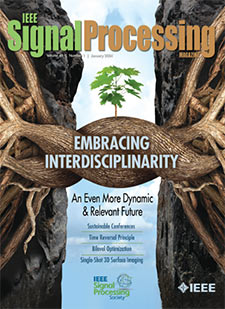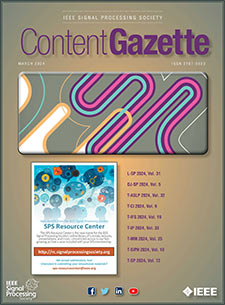- Our Story
- Publications & Resources
- Publications & Resources
- Publications
- IEEE Signal Processing Magazine
- IEEE Journal of Selected Topics in Signal Processing
- IEEE Signal Processing Letters
- IEEE/ACM Transactions on Audio Speech and Language Processing
- IEEE Transactions on Computational Imaging
- IEEE Transactions on Image Processing
- IEEE Transactions on Information Forensics and Security
- IEEE Transactions on Multimedia
- IEEE Transactions on Signal and Information Processing over Networks
- IEEE Transactions on Signal Processing
- IEEE TCI
- IEEE TSIPN
- Data & Challenges
- Submit Manuscript
- Guidelines
- Information for Authors
- Special Issue Deadlines
- Overview Articles
- Top Accessed Articles
- SPS Newsletter
- SigPort
- SPS Resource Center
- Publications Feedback
- Publications FAQ
- Blog
- News
- Dataset Papers
- Conferences & Events
- Community & Involvement
- Professional Development
- For Volunteers
- Information for Authors-OJSP
-
Home
Conferences14 April 2025 to 17 April 2025Conferences Events IEEE JSTSP Article IEEE Signal Processing Magazine IEEE TIFS Article IEEE TMM Article IEEE TSP Article Jobs in Signal Processing Lectures Machine Learning Seasonal Schools Signal Processing News SPM Article SPS Distinguished Lectures SPS Newsletter Article SPS Webinar SPS Webinars SPS Webinar Series Webinar webinars
-
Our Story
What is Signal Processing?

The technology we use, and even rely on, in our everyday lives –computers, radios, video, cell phones – is enabled by signal processing. Learn More » -
Publications & Resources
-
SPS Resources
- Signal Processing Magazine The premier publication of the society.
- SPS Newsletter Monthly updates in Signal Processing
- SPS Resource Center Online library of tutorials, lectures, and presentations.
- SigPort Online repository for reports, papers, and more.
- SPS Feed The latest news, events, and more from the world of Signal Processing.
-
SPS Resources
-
Conferences & Events
-
Community & Involvement
-
Membership
- Join SPS The IEEE Signal Processing Magazine, Conference, Discounts, Awards, Collaborations, and more!
- Chapter Locator Find your local chapter and connect with fellow industry professionals, academics and students
- Women in Signal Processing Networking and engagement opportunities for women across signal processing disciplines
- Students Scholarships, conference discounts, travel grants, SP Cup, VIP Cup, 5-MICC
- Young Professionals Career development opportunities, networking
- Get Involved
-
Technical Committees
- Applied Signal Processing Systems
- Audio and Acoustic Signal Processing
- Bio Imaging and Signal Processing
- Computational Imaging
- Image Video and Multidimensional Signal Processing
- Information Forensics and Security
- Machine Learning for Signal Processing
- Multimedia Signal Processing
- Sensor Array and Multichannel
- Signal Processing for Communication and Networking
- Signal Processing Theory and Methods
- Speech and Language Processing
- Technical Working Groups
- More TC Resources
-
Membership
-
Professional Development
-
Professional Development
- Mentoring Experiences for Underrepresented Young Researchers (ME-UYR)
- Micro Mentoring Experience Program (MiME)
- Distinguished Lecturer Program
- Distinguished Lecturers
- Distinguished Lecturer Nominations
- Past Lecturers
- Distinguished Industry Speaker Program
- Distinguished Industry Speakers
- Distinguished Industry Speaker Nominations
- Industry Resources
- IEEE Training Materials
- Jobs in Signal Processing: IEEE Job Site
-
Career Resources
- SPS Education Program Educational content in signal processing and related fields.
- Distinguished Lecturer Program Chapters have access to educators and authors in the fields of Signal Processing
- PROGRESS Initiative Promoting diversity in the field of signal processing.
- Job Opportunities Signal Processing and Technical Committee specific job opportunities
- Job Submission Form Employers may submit opportunities in the area of Signal Processing.
-
Professional Development
-
For Volunteers
-
For Board & Committee Members
- Board Agenda/Minutes* Agendas, minutes and supporting documentation for Board and Committee Members
- SPS Directory* Directory of volunteers, society and division directory for Board and Committee Members.
- Membership Development Reports* Insight into the Society’s month-over-month and year-over-year growths and declines for Board and Committee Members
-
For Board & Committee Members
Popular Pages
Today's:
- Submit a Manuscript
- (MLSP 2024) 2024 IEEE International Workshop on Machine Learning for Signal Processing
- Information for Authors
- (SLT 2024) 2024 IEEE Spoken Language Technology Workshop
- SPS Scholarship Program
- IEEE Signal Processing Letters
- IEEE Transactions on Image Processing
- IEEE/ACM Transactions on Audio Speech and Language Processing
- IEEE Transactions on Multimedia
- Conference Call for Papers
- IEEE Transactions on Information Forensics and Security
- Information for Authors-SPL
- Signal Processing 101
- Interview with Chetan Arora, Associate Professor, IIT Delhi, India
- IEEE Transactions on Signal Processing
All time:
- Information for Authors
- Submit a Manuscript
- IEEE Transactions on Image Processing
- 404 Page
- IEEE/ACM Transactions on Audio Speech and Language Processing
- IEEE Transactions on Information Forensics and Security
- IEEE Transactions on Multimedia
- IEEE Signal Processing Letters
- IEEE Transactions on Signal Processing
- Conferences & Events
- IEEE Journal of Selected Topics in Signal Processing
- Information for Authors-SPL
- Conference Call for Papers
- Signal Processing 101
- IEEE Signal Processing Magazine
Last viewed:
- Guidelines for Reviewers
- Conference Call for Papers
- (EUSIPCO 2024) 2024 European Signal Processing Conference
- Governance Documents
- IEEE JSTSP Special Issue on Distributed Signal Processing for Extremely Large-Scale Antenna Array Systems
- IEEE JSTSP Special Issue on Near-Field Signal Processing: Algorithms, Implementations and Applications
- IEEE Signal Processing Magazine
- Publications & Resources
- Editorial Board
- Submit a Manuscript
- Signal Processing 101
- IEEE JSTSP Special Issue on Deep Multimodal Speech Enhancement and Separation
- IEEE JSTSP Special Series on AI in Signal & Data Science - Toward Explainable, Reliable, and Sustainable Machine Learning
- IEEE Journal of Selected Topics in Signal Processing
- Awards & Submit Award Nomination
Recent Patents in Signal Processing (December 2014) – Image Denoising
You are here
Newsletter Menu
Newsletter Categories
Top Reasons to Join SPS Today!
1. IEEE Signal Processing Magazine
2. Signal Processing Digital Library*
3. Inside Signal Processing Newsletter
4. SPS Resource Center
5. Career advancement & recognition
6. Discounts on conferences and publications
7. Professional networking
8. Communities for students, young professionals, and women
9. Volunteer opportunities
10. Coming soon! PDH/CEU credits
Click here to learn more.
News and Resources for Members of the IEEE Signal Processing Society
Recent Patents in Signal Processing (December 2014) – Image Denoising
For our December 2014 issue, we cover recent patents granted in the area of image denoising. The section below covers patents granted recently for image de-bluring, enhancement layer video coding, enhanced MRI signal reconstruction, image noise removal, and anisotropic denoising.
An image de-blurring system presented in invention no. 8,897,588 obtains a blurred input image and generates, based on the blurred input image, a blur kernel. The blur kernel is an indication of how the image capture device was moved and/or how the subject captured in the image moved during image capture, resulting in blur. Based on the blur kernel and the blurred input image, a de-blurred image is generated. The blur kernel is generated based on sharp versions of the blurred input image predicted using a data-driven approach based on a collection of prior edges.
In patent no. 8,897,359 techniques and tools for encoding enhancement layer video with quantization that varies spatially and/or between color channels are presented, along with corresponding decoding techniques and tools. For example, an encoding tool determines whether quantization varies spatially over a picture, and the tool also determines whether quantization varies between color channels in the picture. The tool signals quantization parameters for macroblocks in the picture in an encoded bit stream. In some implementations, to signal the quantization parameters, the tool predicts the quantization parameters, and the quantization parameters are signaled with reference to the predicted quantization parameters. A decoding tool receives the encoded bit stream, predicts the quantization parameters, and uses the signaled information to determine the quantization parameters for the macroblocks of the enhancement layer video. The decoding tool performs inverse quantization that can vary spatially and/or between color channels.
Magnetic susceptibility is the physical property for T2*-weighted magnetic resonance imaging (T2*MRI). The invention no. 8,886,283 relates to methods for reconstructing an internal distribution (3D map) of magnetic susceptibility values of an object, from 3D MRI phase images, by using Computed Inverse Magnetic Resonance Imaging (CIMRI) tomography. The CIMRI technique solves the inverse problem of the 3D convolution by executing a 3D Total Variation (TV) regularized iterative convolution scheme, using a split Bregman iteration algorithm. The reconstruction of magnetic susceptibility can be designed for low-pass, band-pass, and high-pass features by using a convolution kernel that is modified from the standard dipole kernel. Multiple reconstructions can be implemented in parallel, and averaging the reconstructions can suppress noise. 4D dynamic magnetic susceptibility tomography can be implemented by reconstructing a 3D susceptibility volume from a 3D phase volume by performing 3D CIMRI magnetic susceptibility tomography at each snapshot time.
An image denoising method from patent no. 8,885,965 includes the steps of: sequentially selecting a pixel in an image as a current pixel; dynamically determining a current search block and a strength parameter; pre-denoising the comparison block of each pixel in the current search block; comparing the comparison block of the pre-denoised neighborhood pixel and the comparison block of the pre-denoised current pixel to obtain a similarity between each neighborhood pixel and the current pixel in the current search block; determining a weighting of each neighborhood pixel related to the current pixel according to the strength parameter, and a distance and the similarity between each neighborhood pixel and the current pixel in the current search block; and weighted averaging each neighborhood pixel and the current pixel in the current search block according to the weighting to obtain a reconstruction value of the current pixel.
In patent no. 8,885,961 a method is presented for removing noise from an image receiving image data including a plurality of pixels. A graph including a plurality of nodes and a plurality of edges interconnecting the nodes is formulated. Each pixel of the image data is represented as a node of the graph and each edge of the graph is assigned a weight based on a penalty function applied to the nodes connected by the edge where the penalty function is less when a value of a given pixel of the plurality of pixels is between or equal to the values of two neighboring pixels than when the value of the given pixel is either greater than or less than the values of both of the two neighboring pixels. A total penalty of the graph is minimized. A denoised image is provided based on the total penalty-minimized graph.
Finally in accordance with an embodiment of the invention no. 8,879,841, an anisotropic denoising method is provided that removes sensor noise from a digital image while retaining edges, lines, and details in the image. In one embodiment, the method removes noise from a pixel of interest based on the detected type of image environment in which the pixel is situated. If the pixel is situated in an edge/line image environment, then denoising of the pixel is increased such that relatively stronger denoising of the pixel occurs along the edge or line feature. If the pixel is situated in a detail image environment, then denoising of the pixel is decreased such that relatively less denoising of the pixel occurs so as to preserve the details in the image. In one embodiment, detection of the type of image environment is accomplished by performing simple arithmetic operations using only pixels in a 9 pixel by 9 pixel matrix of pixels in which the pixel of interest is situated. As a result, improved image environment sensitive noise reduction is achieved that requires a relatively low gate count in hardware implementations.
If you have an interesting patent to share when we next feature patents related to image denoising, or if you are especially interested in a signal processing research field that you would want to be highlighted in this section, please send email to Csaba Benedek (benedek.csaba AT sztaki DOT mta DOT hu).
References
Number: 8,897,588
Title: Data-driven edge-based image de-blurring
Inventors: J. Wang, S. Cho and L. Sun
Issued: November 25, 2014
Assignee: Adobe Systems Incorporated (San Jose, CA)
Number: 8,897,359
Title: Adaptive quantization for enhancement layer video coding
Inventors: S. Regunathan, S. Sun, C. Tu, C-L. Lin
Issued: November 25, 2014
Assignee: Microsoft Corporation (Redmond, WA)
Number: 8,886,283
Title: 3D and 4D magnetic susceptibility tomography based on complex MR images
Inventors: Z. Chen and V.D. Calhoun
Issued: November 11, 2014
Assignee: STC.UNM (Albuquerque, NM)
Number: 8,885,965
Title: Image denoising method
Inventors: S.S. Yang, W.H. Yao and C.H. Lee
Issued: November 11, 2014
Assignee: PixArt Imaging Inc (Hsin-Chu County, TW)
Number: 8,885,961
Title: System and method for image denoising optimizing object curvature
Inventors: N. Y. El-Zehiry and L. Grady
Issued: November 11, 2014
Assignee: Siemens Aktiengesellschaft (Munich, DE) )
Number: 8,879,841
Title: Anisotropic denoising method
Inventors: N. Cohen, J. Danowitz and O. Liba
Issued: November 4, 2014
Assignee: Fotonation Limited (Ballybrit, Galway, IE
Open Calls
Conference News
Society News
Research Opportunities
PhD Theses
Initiatives & Trends
Chapter & DL News
News & Announcements
- SPS Announces 2015 Class of Distinguished Lecturers
- New IEEE Internet of Things Initiative (IoT) Newsletter Announced
- TryEngineering.org Goes Mobile
- Introducing a Low-Cost Online Registration Tool for Conference and Event Management
- Member Discounts: IEEE Member Travel Discount Features Benefit Conference Attendees
- IEEE-USA Offers Free e-Books to Members in October, November, and December
- Member Loyalty Program Lets Sections Recognize Members for their Years of Membership
- vTools Release Announcement
SPS on Twitter
- DEADLINE EXTENDED: The 2023 IEEE International Workshop on Machine Learning for Signal Processing is now accepting… https://t.co/NLH2u19a3y
- ONE MONTH OUT! We are celebrating the inaugural SPS Day on 2 June, honoring the date the Society was established in… https://t.co/V6Z3wKGK1O
- The new SPS Scholarship Program welcomes applications from students interested in pursuing signal processing educat… https://t.co/0aYPMDSWDj
- CALL FOR PAPERS: The IEEE Journal of Selected Topics in Signal Processing is now seeking submissions for a Special… https://t.co/NPCGrSjQbh
- Test your knowledge of signal processing history with our April trivia! Our 75th anniversary celebration continues:… https://t.co/4xal7voFER
Home | Sitemap | Contact | Accessibility | Nondiscrimination Policy | IEEE Ethics Reporting | IEEE Privacy Policy | Terms | Feedback
© Copyright 2024 IEEE – All rights reserved. Use of this website signifies your agreement to the IEEE Terms and Conditions.
A not-for-profit organization, IEEE is the world's largest technical professional organization dedicated to advancing technology for the benefit of humanity.







